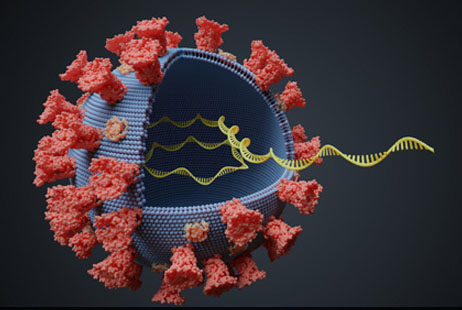COVID-19 News: New SARS-CV-2 Variant B.1.258 Emerges In Czech Republic And Slovakia Carrying H69/V70 Deletion, N439K And Numerous Mutations
Source: COVID-19 News Feb 08, 2021 4 years, 2 months, 2 weeks, 5 days, 23 minutes ago
COVID-19 News: A new variant called B.1.258 that is fast spreading across certain parts or Europe has been discovered in Czech Republic and Slovakia carrying the ∆H69/∆V70 deletion, the N439K and numerous other mutations.
https://virological.org/t/b-1-258-a-sars-cov-2-variant-with-h69-v70-in-the-spike-protein-circulating-in-the-czech-republic-and-slovakia/613
 Credit: Istock/vchal
Credit: Istock/vchal
The new
B.1.258 variant carrying the ∆H69/∆V70 mutation in the spike protein that has emerged within the B.1.258 clade and has been prevalent in the Czech Republic (approx. 59% out of 251 sequenced samples between September and December 2020), Slovakia (25% out of 72 sequenced samples in the same months), and several other countries .
The ∆H69/∆V70 deletion in the Spike N-terminal domain (NTD) is associated with increased infectivity and evasion of the immune response.
https://www.medrxiv.org/content/10.1101/2020.12.05.20241927v3
Evidence suggests that this mutation has arisen in B.1.258 independently of the B.1.1.7 variant.
Importantly diagnostic laboratories have to take note that ∆H69/∆V70 deletion is likely to cause a drop-out of the Spike gene target in TaqPath RT-qPCR and other assays targeting this deletion, and thus its carriers can be easily misidentified as B.1.1.7 as it recently happened in Slovakia.
https://www.medrxiv.org/content/10.1101/2020.12.24.20248814v1
https://www.medrxiv.org/content/10.1101/2020.11.10.20228528v3
https://virological.org/t/tracking-sars-cov-2-voc-202012-01-lineage-b-1-1-7-dissemination-in-portugal-insights-from-nationwide-rt-pcr-spike-gene-drop-out-data/600
It has been demonstrated that ∆H69/∆V70 enhances the virus infectivity by two-folds in a pseudotyping assay.
Importantly the B.1.258∆ variant also contains the N439K mutation in the receptor binding domain (RBD) of the Spike protein. The N439K substitution enhances the binding affinity to the angiotensin-converting enzyme 2 (ACE2) receptor and has been shown to facilitate immune escape from a panel of neutralizing monoclonal antibodies, as well as from polyclonal sera from persons recovered from the infection. This mutation is also associated with slightly higher viral loads.
https://www.cell.com/cell/pdf/S0092-8674(21)00080-5.pdf?_returnURL=https%3A%
2F%2Flinkinghub.elsevier.com%2Fretrieve%2Fpii%2FS0092867421000805%3Fshowall%3Dtrue
The other non-synonymous mutations characteristic for most of the B.1.258∆ samples result in amino acid substitutions in proteins involved in virus replication,
i.e. M101I, localized in the dimerization motif ‘GXXXG’ (100-104) of RNA-binding protein NSP9, V720I in the palm subdomain of RNA-dependent RNA polymerase NSP12, and A598S near the C-terminus of helicase NSP13.
https://link.springer.com/article/10.1186/s43556-020-00005-0
https://www.researchsquare.com/article/rs-49671/v1
It is suspected that the non-synonymous mutations in NSP9, NSP12 and NSP13 likely enhance viral replication thus leading to higher viral loads in infected human hosts.
Researchers are warning that the association of mutations in the B.1.258∆ variant with increased virulence and evasion of immune responses taken together with the high prevalence in several countries (notably the Czech Republic, currently reporting one of the highest incidences of new cases per 100,000 population in the world) warrants further investigation of this variant.
The new B.1.258 variant is also fast spreading in counties like Sweden, Poland, Germany, Netherlands, Denmark and Iceland.
What is worryingly however is that researchers are observing that those detected with the new B.1.258 variants tend to have higher viral loads and exhibit disease severity.
Also worrying is that a sublineage of B.1.258∆ variant has also emerged ie the B.1.258.17 variant which has accumulated a higher number of mutations compared to other B.1.258∆ samples, including additional substitutions in the Spike protein (L189F, V772I) and helicase NSP13 (P53L). It also has a substitution Q185H in the second B cell epitope of ORF3a protein involved in apoptosis induction.
https://www.nature.com/articles/s41423-020-0485-9
While the world is currently too engrossed in the COVID-19 vaccines and neglecting a more dire need for therapeutics drugs especially anti-virals, it will pay dearly in the coming catastrophic COVID-19 third wave which is expected around the months of May or June or even maybe earlier with the emergence of more potent variants and the ‘backfiring’ of the current vaccination strategies.
For the latest
COVID-19 News, keep on logging to Thailand Medical News.
